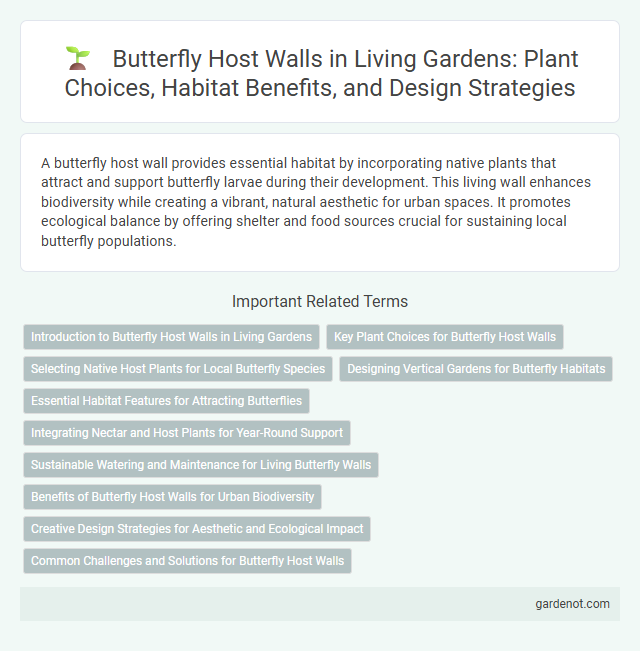A butterfly host wall provides essential habitat by incorporating native plants that attract and support butterfly larvae during their development. This living wall enhances biodiversity while creating a vibrant, natural aesthetic for urban spaces. It promotes ecological balance by offering shelter and food sources crucial for sustaining local butterfly populations.
Introduction to Butterfly Host Walls in Living Gardens
Butterfly host walls serve as specialized vertical habitats designed to support specific host plants essential for butterfly larvae development in living gardens. These walls enhance biodiversity by providing critical resources for caterpillars, promoting butterfly population growth and ecological balance. Integrating butterfly host walls into garden designs fosters natural pollination and creates vibrant, sustainable outdoor spaces.
Key Plant Choices for Butterfly Host Walls
Essential key plant choices for Butterfly Host Walls include milkweed species (Asclepias), crucial for monarch butterfly larvae development, and dill (Anethum graveolens), favored by black swallowtails. Incorporating native plants such as violets (Viola spp.) supports fritillary butterflies, while passionflower (Passiflora incarnata) serves as a host for gulf fritillary caterpillars. Optimal selection enhances butterfly habitat, promotes biodiversity, and ensures a thriving host wall ecosystem.
Selecting Native Host Plants for Local Butterfly Species
Choosing native host plants for a butterfly host wall supports local butterfly populations by providing essential resources for egg laying and caterpillar development. Native plants such as milkweed for monarchs or passionflower for gulf fritillaries create habitat continuity and improve butterfly survival rates. Incorporating a diverse range of region-specific host plants enhances pollinator biodiversity and strengthens urban ecosystems.
Designing Vertical Gardens for Butterfly Habitats
Designing vertical gardens as butterfly habitats involves selecting native host plants that cater to specific butterfly species, ensuring nourishment for their larvae. Incorporating diverse plant layers and varying bloom times supports butterfly life cycles and attracts a wide array of pollinators. Proper positioning for sunlight and moisture retention enhances the living wall's suitability, creating a thriving, sustainable butterfly ecosystem.
Essential Habitat Features for Attracting Butterflies
Essential habitat features for attracting butterflies to a butterfly host wall include the presence of native host plants where butterflies can lay their eggs and caterpillars can feed, such as milkweed for monarchs or dill and parsley for swallowtails. Incorporating nectar-rich flowering plants like lantana, butterfly bush, and coneflowers provides vital food sources for adult butterflies. A sheltered structure with adequate sunlight, moisture, and protection from strong winds enhances butterfly activity and promotes a thriving habitat on the living wall.
Integrating Nectar and Host Plants for Year-Round Support
A Butterfly host wall integrates a diverse selection of nectar and host plants to provide essential resources for butterflies throughout all seasons. Host plants such as milkweed and parsley offer critical breeding sites, while nectar-rich flowers like lantana and coneflowers supply continuous nourishment. This combination ensures year-round habitat sustainability, promoting healthy butterfly populations and biodiversity in urban environments.
Sustainable Watering and Maintenance for Living Butterfly Walls
The Butterfly Host Wall integrates a sustainable watering system featuring drip irrigation and rainwater harvesting to minimize water usage while supporting butterfly habitat health. Its low-maintenance design includes drought-tolerant native plants that reduce the need for frequent watering and fertilizers, promoting an eco-friendly environment. Automated sensors monitor soil moisture, ensuring optimal hydration and reducing maintenance efforts for long-lasting vibrancy and ecological balance.
Benefits of Butterfly Host Walls for Urban Biodiversity
Butterfly host walls enhance urban biodiversity by providing essential habitats for butterfly larvae and adult pollinators, supporting species survival amid city environments. These vertical gardens improve ecological connectivity, facilitating butterfly movement between green spaces while aiding in plant pollination and local ecosystem resilience. Incorporating native host plants on butterfly walls promotes genetic diversity and contributes to balanced urban ecosystems, fostering sustainable urban wildlife habitats.
Creative Design Strategies for Aesthetic and Ecological Impact
Butterfly host walls integrate native plant species specifically selected to support local butterfly populations, enhancing biodiversity and creating visually striking vertical gardens. Utilizing layered plant arrangements and seasonal flowering cycles maximizes both aesthetic appeal and ecological function by providing continuous habitats and food sources. Incorporating structural elements such as varied textures and natural materials further enriches the microhabitat, promoting butterfly activity while elevating urban green space design.
Common Challenges and Solutions for Butterfly Host Walls
Common challenges for butterfly host walls include selecting native plant species that support local butterfly populations, managing pests without harmful chemicals, and ensuring adequate sunlight and moisture levels. Solutions involve planting a diverse array of host plants like milkweed for monarchs, using organic pest control methods, and designing irrigation systems that maintain optimal soil hydration. Proper site assessment and ongoing monitoring help sustain a thriving butterfly habitat and promote biodiversity.
Butterfly host wall Infographic

 gardenot.com
gardenot.com